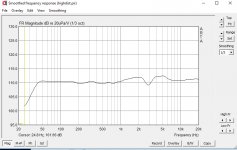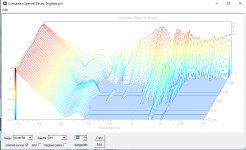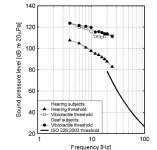The best definition imo for near field vs far field is that near field decreases by 3 db for each doubling of distance. Far field decreases by 6 db. Thus its the difference between a point and a line.
This is a good article on it. Line Array Limitations
There isn't a neat transition point, longer wavelengths transition closer.
I don't think that true in general, but it is for a line source. For a piston the near field is like a columnated (sp?) beam, it goes straight out like a flashlight. There is no fall-off, except that along the way there are several peaks and dips. The higher the frequency the more of these until at LFs they just disappear.
We did a lot of work on the relationship between what we hear and what we feel at LFs while I was at Ford in Noise control. Turns out that starting at about 100 Hz., the lower you go the more important the tactile feel becomes until about 20 Hz you only feel the sound, almost nothing is airborne. Without a tactile feel the perception of bass is never right.
That is an interesting observation. There's been an increase in research in low frequency perception the past few years over concerns regarding health and low frequency noise pollution from wind farms and I've chanced to read some of it. Some of it has noted that at your mentioned 100Hz, the ear shifts from being dominated by sound pressure and inner hair cells to particle velocity and the outer hair cells as frequency decreases with particle velocity becoming the dominant mode roughly an octave above your mark of 20Hz (with ten times to voltage output on the nerve to boot, though there does seem to be a blanking phenomenon that occurs when much higher frequency content comes back into play). Perhaps that has some relation to the tactile sensation you mention?
I wonder about that as, again, with the more recent studies there have been findings that, in fact, the audible signal is the more important in perceiving low frequencies. There was one study in particular I found that is especially interesting in that it compares low frequency audibility between hearing test subjects who would both hear and feel the bass and deaf test subjects who would be limited to pure tactile perception. The results? The hearing subjects heard 20Hz bass 30dB lower than the deaf testers could feel it and could still hear 3Hz roughly ten dB before it could be felt. (Measured at SPL only.) When tactile perception was looked at, the hearing subjects still "felt" the bass a few dB before the deaf subjects. I've attached a graph of the results to better visualize it.
So, low bass is definitely heard, not merely felt, but it does seem to be "felt" when heard just a little perhaps through some sort of synaesthetic bleed over between the senses. Given how many times I've "felt" a bit of low bass when listening to music on my IEMs, I'm not surprised at that at all.
Attachments
When we listen to low sine at home, what we hear are mostly distortion components. Hardly anyone has a subwooer that is capable of clean 20Hz above audibility treshold.
It was some open ear headphones in my case. Just turned down the oscillator frequency gradually and the tone got deeper and deeper and deeper, never sounded perceptually like it switched or transitioned to any type of harmonic to me. Slowly swept the oscillator up and down in frequency a few times listening for any evidence of mode changes, but detected none. Oh well, I thought at the time, I guess it is possible to hear below 20Hz. Much later I heard Sean Olive say the old 20Hz to 20kHz range is a very rough approximation. He said young children may hear up to 30kHz or possibly higher, but by age 25 it was mostly limited to about 16kHz. That's on the high end of course. People still argue about that as well.
I'm sorry, but this is not correct. The CSD derives directly from the impulse response, the exact same impulse response whose Fourier Transform is the frequency response. There cannot be any information in one that is not in the other.
The example that you state could not exist in the real world because it would be impossible. The FR at t=0 is based on everything that follows after t=0, all the exact same information that is in the CSD.
As I said there is one single situation that can occur where one could not guess the CSD from the FR and that is a dual close resonance, like in a room. When a room has two modes close by and is excited by a tone between them, the steady state sound field will be at the excitation frequency, but the room sound will decay at the two frequencies of the modes. Hence the FR would show a shallow peak at the driven frequency, but the decay - the CSD - would show two separate sharp peaks. But in a loudspeaker this would be a very uncommon situation, although I have seen it.
Earl, you should know this and I am sure that you do so I am puzzled. The FR and the CSD are indeed derived from the same impulse response, but they contain different information. The reason is that the FR is the impulse response with the window starting at t=0. For each subsequent slice of the CSD, this window slides over the impulse response with a fixed time interval. It thus shows the decay of the original impulse response.
For good measure I include two plots where the same impulse response is processed first into the FR, and then into the CSD.

Frequency response

Cumulative decay
There is no predicting the CSD plot from the FR. With the same FR, the CSD plot could stop on a dime or go on forever. Only correct processing from the impulse response will subtract the cumulative decay information from it. This information gets lost in the FR because it only looks at the impulse response with the window starting at t=0.
I would have loved to post this immediately after reading yours, but I was travelling, sorry for the delay.
Aliexpress.com : Buy 2017 New Boarseman KR25D In Ear Earphone Hifi Bass Alloy Tune Dynamic Earbuds Noise Cancelling For IPhone Android PC from Reliable in ear earphones suppliers on AK Audio store
I'm ordering these on 11/11 because I can save two dollars. I don't normally listen to headphones but hey why not, I deserve it.
The are made out of 'mental' material. Should be crazy.
For those who think that CSD shows anything unique, consider this:
I have only the frequency response, but of course, I also need the phase. I take that response and do an inverse FFT on it to return the impulse response. Next I take this impulse response and calculate the CSD.
From this procedure you can see that the two things are completely related to each other. Some things are more obvious in one than the other but they both show exactly the same information.
Nonsense. You can't retrieve information that was outside the window of the first FFT.
They are somewhat related, but the larger the diaphragm, in relation with the stiffness of material, there will be certain things that are not predictable. Just last week I sent Peter Larsen some data, hoping that his software could simulate such design in some way. Yes, I did have to show him some Klippel scans to at least draw his interest. There are lots of things I hope would make trying out some new concepts easier.
The are made out of 'mental' material. Should be crazy.
ha, If they're not made out of mental I'll have to get a refund.
Dr. "Shwiensgruber" heartily recommends them in the comments section. The secret, I'm sure, is in the mental material.
Review: boarseman KR25D - AudioBudget
Last edited:
Nonsense. You can't retrieve information that was outside the window of the first FFT.
I think that you need to think this through better, because it is a simple fact that I can generate the CSD from the t=0 response alone. This means that all the information in the CSD is contained in the t=0 result. This should be obvious since the impulse response contains all information and the CSD is just showing ever smaller portions of it. At no time does the CSD use any data that is not in the original t=0 response. Windowing, as you imply, is not the answer here.
@ post 746
Vac, what you show is rather amazing.
Firstly, the FR is 1/3 smoothed, whereas the waterfall is unsmoothened.
Such heavy smoothing makes narrow band dips and peaks disappear.
Secondly, the waterfall O dB line stops providing usefull FR info below 1000 Hz, which info is in the FR plot, running to 20 Hz.
Basically the 0 dB line in the Waterfall should be identical to the FR plot, although the graphic presentation of the FR usually looks a bit smoother, because of somewhout different scaling.
And now you want us to believe both plots are derived from one and the very same impulse without touching the windowing markers in ARTA, in other words with the markers in exactly the same spot?
Eelco
Vac, what you show is rather amazing.
Firstly, the FR is 1/3 smoothed, whereas the waterfall is unsmoothened.
Such heavy smoothing makes narrow band dips and peaks disappear.
Secondly, the waterfall O dB line stops providing usefull FR info below 1000 Hz, which info is in the FR plot, running to 20 Hz.
Basically the 0 dB line in the Waterfall should be identical to the FR plot, although the graphic presentation of the FR usually looks a bit smoother, because of somewhout different scaling.
And now you want us to believe both plots are derived from one and the very same impulse without touching the windowing markers in ARTA, in other words with the markers in exactly the same spot?
Eelco
I think that you need to think this through better, because it is a simple fact that I can generate the CSD from the t=0 response alone. This means that all the information in the CSD is contained in the t=0 result. This should be obvious since the impulse response contains all information and the CSD is just showing ever smaller portions of it. At no time does the CSD use any data that is not in the original t=0 response. Windowing, as you imply, is not the answer here.
What you say is true. But then we have to figure out ways to look at how much of t=0 still remains beyond t=0, do you know of a better way to show it? How will it assist in showing deficiencies more clearly? How will it more clearly show differences related with audible differences?
Last edited:
I do get that no one is really saying they all sound the same, HD rarely is the number one character when defining sound quality.
I do have an example where cleaner woofers make an audible difference that shows up in the frequency domain due to reduced harmonic distortion of the drivers.
I have a pair of JBL 4430’s. They have a single 2235 woofer and they sound pretty good. I also have 4435’s with the dual 2234’s in them and they sound a lot better, on the bottom, much cleaner and tighter.
The one inch drivers on the 4435’s are the limiting factor for listening loud, they start to get hard when you lean on them. The 4430’s are pretty ballanced as both drivers approach their limits about the same time.
Here’s the main difference, the dual 15’s have about 1/10 the distortion at the same volume as the single, according to the JBL owners manual for the 4430-4435.
So here comes a pair of 4350’s with 2235’s. They have the same sound character on the bottom (250Hz and down) as the 4435’s but will play way louder than the 4435’s overall, as expected.
Where is this all going? The 4430 has midbass growth at high volume that I originally attributed to something I have heard explained as “overdriving the room” or stored energy in the modal region. Pretty much all my systems have displayed this to some extent. The midbass gets muddy with volume BUT,, the dual 15” 4435 and 4350 exhibit this less.
Here’s my big argument to this whole distortion in woofers is meaningless:
I bought four JBL 1500Al woofers as used in the DD6600. These are what JBL calls ultra low distortion woofers, like 0.1% HD at 100 Watts input power as compared to the several whole number percent HD 2235’s and guess what?
The mid bass growth phenomenon is totally absent in the 4350’s with these ultra low distortion drivers.
I attribute this to the absence of increasing false additional mid-bass generated by the driver when operating at high levels.
Increasing HD as drive level increases is a nonlinear distortion that I can easily discern in woofers in this case.
Barry.
You are exactly correct here, it is HD and/or IMD and it is audible. I've observed the same
thing with different speakers. No, I did not do a double blind experiment. Your speakers
and mine are "well behaved" with gradual onset of non-linearity allowing us to push them
hard so that we can hear the gradual onset of HD.
Earl, made his assertions based on specific contrived experiments.
An untrained listener will hear more bass in the distorted speaker and MIGHT like it more - I don't.
I also believe that the observations will change when a better reference is available
in A/B comparisons.
I started a thread one time: "When Bad is Good".
Audio and especially human perception are complex.
Last edited:
Earl, made his assertions based on specific contrived experiments.
Earl's problem is that he's never heard ear buds made of "mental material".
I should point out that it is not just me that believe this, it is also professed by JBL's entire engineering staff and The THX people, just to name a few. I just happen to be the only one willing (or crazy enough) to come to the forums to express those beliefs.
And any results that are reported that are not blind can certainly not be held up as evidence against tests done correctly.
Forums should be a place for brainstorming and finding ways to improve on existing technology. Let’s focus on ideas rather than trying to discredit people. Everyone has different experiences, and we know that audio systems are far from perfect. How can we move to improve on existing methods should be much more productive.
I should point out that it is not just me that believe this, it is also professed by JBL's entire engineering staff and The THX people, just to name a few.
That's JBL's problem too, they don't use "mental material". In all seriousness though a lot depends on personal preferences and what one is willing to put up with or adjust to. Linear distortion and dispersion are generally recognized to be more important that other types of distortion.
Electronics and amps are for the most part transparent.
Last edited:
Forums should be a place for brainstorming and finding ways to improve on existing technology.
^this
Member
Joined 2009
Paid Member
subjectively, I've thought of near-field as being too close to use multi-way speakers due to poor integration of the sound. As soon as I'm far enough that a multi-way speaker sounds coherent then I'm no longer in the near-field. For computer speakers, single driver full-range is the way to go.
- Home
- Loudspeakers
- Multi-Way
- Who makes the lowest distortion speaker drivers
